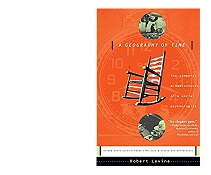What We're Reading Now
Reflections on Time
3 April 2018
Geof read A Geography of Time: The Temporal Misadventures of a Social Psychologist by Robert Levine, and was interested to read Levine's research on the pace of life in different cultures.
Tags: geof read, time management and prioritization
“I've been from private school polos to sweet jail of Canada, and slept on the most random couches and floors. I'm a spoiled yuppie punk and maybe that’s not all I'm after, but I've seen things people pay calendars for.”
Steamboat Willie
Walter Mitty and His Makeshift Orchestra
That’s a song lyric by the band Walter Mitty and His Makeshift Orchestra. That last line, “I’ve seen things people pay calendars for,” has resonated with me since first hearing. First, it’s a clever way to talk about time as a commodity we choose to spend. Second, by using “calendars” it forces the listener to think about what activities he or she is spending big parts of his or her life doing. How have the “moments” of activities added up, and for what activities do you choose to pay calendars? Finally, there is a nice juxtaposition to the quality of life – from “private school polos to Canadian jails” – proposed by the lyrics. What impact does the pace at which we live and the choices we make have on our quality of life?
In search of answers to some of these questions I’ve been reading A Geography of Time: On Tempo, Culture, and the Pace of Life by Robert Levine. Levine explores the relationship of time on culture and how cultures might differ from one another based on their chosen “pace.”

As part of his studies, Levine and team conducted research to compare (and rank) the pace of 31 different cities and countries. He is very careful to point out that the goal is not to create a “Top (insert superlative here) Cities to live ….” type expose. Instead, he’s curious about the relationship between a culture’s pace of life and its quality of life. “Since time is the very cornerstone of social life, the study of a people’s temporal constructions offers a precious window into the psyche of culture…”
Of particular interest was the research methodology Levine used to measure the pace among the 31 cities, including the three indicators:
“Eventually three measures of the pace of life were developed:
- Walking speed – the speed with which pedestrians in downtown areas walk a distance of 60 feet (about a city block);
- Work speed – how quickly postal clerks complete a standard request to purchase a stamp; and
- The accuracy of public clocks.”
I won’t spoil the results of the ranking (however the U.S. was in the middle at 16th) – And Levine does a wonderful job of pointing out the benefits of each city’s (and cultures) relationship with time. There is in fact no “right or wrong” perspective of time or pace because of the merged relationship of time and culture. A countries pace is informed by it’s culture and vice versa.
The reason I share is as a point of reflection on our own use of time. What “measures” might you identify to evaluate your own pace of life? What impact might a slower or quicker pace have on the quality of your life? What are you now “paying calendars for” and is it time to consider other activities?







Comments
Our Comment Policy:
Our blog posts are only half of the conversation. What our readers have to say is equally important to us, and we're grateful for all the comments that continue the dialog.
To ensure that the discussion here is as useful as possible to all of our readers, please be respectful of our contributors and refrain from harassing, threatening and/or vulgar language. We reserve the right to screen and remove any comments from the site. If you have a question about a comment or want to discuss our policy, please contact us. We'll talk it over.
There are no comments for this entry yet.